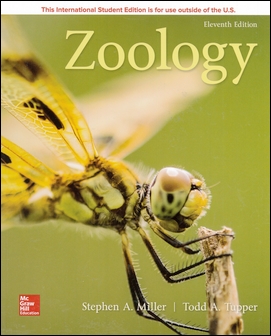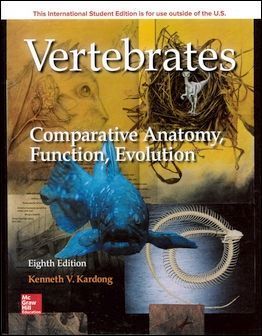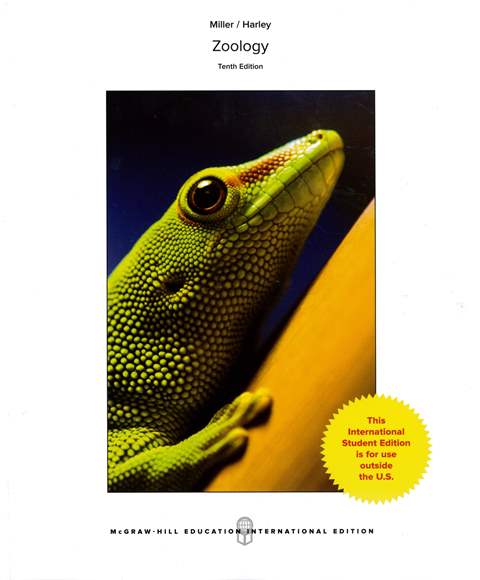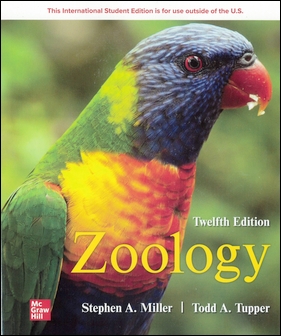書籍分類

Zoology 11/e
作者:Stephen A. Miller, Todd A. Tupper
原價:NT$ 1,750
內容介紹 本書特色 目錄 作者介紹
- Description
The 11th edition of Zoology continues to offer students an introductory general zoology text that is manageable in size and adaptable to a variety of course formats. It is a principles-oriented text written for the non-majors or the combined course, presented at the freshman and sophomore level.
- NEW TO THE ELEVENTH EDITION
As with earlier revisions of Zoology, the focus for this revision has on presenting evolutionary and ecological concepts and accurately using examples from current literature as convincingly as possible. The revisions highlighted below should impress students with the excitement experienced in zoology as new information clarifies zoological concepts and informs our understanding of phylogenetic relationships.
Chapter 1 (Zoology: An Evolutionary and Ecological Perspective)
A new introduction emphasizes the importance of zoological studies in our modern world. Population, world resources, and threatened and endangered species statistics have been updated with 2018 data. Table 1.4 is new and presents information on the major contributors of anthropogenic greenhouse gas emissions.
Chapter 2 (The Structure and Function of Animal Cells)
This chapter has been completely rewritten. It begins with the properties and common origin of cells. Coverage of cells is organized by common functions. It begins with cellular membranes and membrane transport, followed by energy processing. Five new figures (2.11 -2.13 and 2.15-2.16) and new text art support an introduction to enzymes, ATP, glycolysis, the citric acid cycle, electron transport and chemiosmosis. This coverage provides important background for material that comes later, on energy flow in ecosystems, animal temperature regulation, nutrition, and related topics. The descriptions of the nucleus, ribosomes, and vaults are followed by coverage of functions of the endomembrane system, which are supported by the newly rendered figure 2.19. Peroxisomes, the cytoskeleton, and an introduction to tissues, organs, and organ systems follow. Detailed descriptions of tissue types have been moved to the appropriate system in chapters 23 through 29.
Chapter 3 (Cell Division and Inheritance)
A new section on cell-cycle control has been added to this chapter.
Chapter 4 (Evolution: History and Evidence)
The introduction to chapter 4 has been rewritten. In an era in which the validity of science is under attack, students need to be reminded of what a scientific theory is and the work involved with establishing scientific theories. We believe that the beginning of this chapter is the right place to present such a reminder. The revival of the epigenetics movement is briefly addressed. A new section entitled "Geological Time and Mass Extinctions" has been added to this chapter. This content is referenced throughout the book, and it is presented visually in appendix B, where it can be easily accessed. The "Evolutionary Insights" reading on cat phylogeny has been updated and illustrates how data from multiple disciples contribute to our understanding of evolutionary pathways. The cat phylogeny in box figure 4.1 has also been updated.
Chapter 5 (Evolution and Gene Frequencies)
In chapter 5, we have included an expanded discussion of neutral theory and genetic drift. A new example of founder effect (the brown anole lizard) is presented. The discussion of the effects of limiting gene flow through human influences is expanded with new examples that describe the loss of genetic diversity in bighorn sheep through highway construction and in polar bear populations as a result of sea-ice melting.
Chapter 6 (Ecology: Preserving the Animal Kingdom)
In chapter 6, the discussions of community stability and ecosystem trophic structure have been revised, including a discussion of biomagnification in the latter. Statistics on human population growth have been updated. We have added a new section entitled "Earth's Resources and Global Inequality," whre students are challenged to consider overconsumption in western cultures. The material on biodiversity is revised with additional discussion on its preservation and five reasons it is threatened.
Chapter 7 (Animal Taxonomy, Phylogeny, and Organization)
Chapter 7 is updated with a newly written section on taxonomic methods. It compares the usefulness of analyses of genomic DNA, mitochondrial DNA, ribosomal RNA, and noncoding DNA sequences in phylogenetic studies. It emphasizes the importance of both molecular and traditional taxonomic data in these studies. There is a new discussion, and supporting figures, illustrating the construction of simple cladograms from phenotypic characters. A new "How Do We Know" boxed reading does the same using data from DNA base sequences.
Chapter 8 (Animal Origins and Phylogenetic Highlights)
Chapter 8 is new in the eleventh edition of Zoology. It begins with a discussion of Earth's beginning and evidence of early life. It continues by presenting what is known of events occurring within the first 3 billion years of Earth's history. It surveys hypotheses regarding life's origin and the evolution of the three domains, including the importance of horizontal gene transfer in early evolutionary events. The role of endosymbiosis in the origin of eukaryons is discussed. This presentation is followed by a discussion of the origins of multicellularity and animal origins within the eukaryotic clade Opisthokonta. The name "Apoikozoa" is introduced to designate the monophyletic choanoflagellate/animal lineage within Opisthokonta. A discussion of the Cambrian explosion follows. Chapter 8 ends with phylogenetic highlights of Animalia, including an introduction to the basal phyla, Protostomia, and Deuterostomia. We believe that this new chapter establishes a firm connection between the discussion of evolutionary theory in chapters 4 and 5, phylogenetics in chapter 7, and the survey of the animal phyla in chapters 9 through 22.
Chapters 9 through 17
Chapters 9 through 17 survey the animal phyla through the invertebrate chordates. They have been carefully revised and include smaller changes that clarify phylogenetics and natural history. We have included additional examples, often focusing on anthropogenic changes that threaten members of each group of animals. Wildlife Alerts have been rewritten in chapter 11 (freshwater bivalves) and chapter 16 (sea cucumbers). Boxed readings on sponge defenses (chapter 9) and early deuterostome evolution (chapter 17) have also been significantly revised.
Chapter 18 (The Fishes: Vertebrate Success in Water)
Chapter 18's coverage of early craniate evolution has been rewritten. The evolutionary history of early bony fishes has been revised, including new information on the evolution of paired appendages and jaws within the placoderms.
Chapter 19 (Amphibians: The First Terrestrial Vertebrates)
Revision of chapter 19 includes updated information on amphibian origins and origins of the Lissamphibia. Descriptions of all the extant amphibian orders have been rewritten with expanded coverage of the natural history of members of each order. The "Evolutionary Pressures" section has been updated and enhanced with expanded coverage and additional examples of amphibian adaptations. The section describing the endangered status of many amphibians has been rewritten and expanded. This section includes both anthropogenic threats like habitat destruction and "enigmatic" threats, including the spread of the chytrid fungus and climate change.
Chapter 20 (Nonavian Reptiles: Diapsid Amniotes)
Chapter 20 includes a new introduction to the two extant amniote lineages. We have consistently used the designations "nonavian reptiles" to refer to the traditional vertebrate class "Reptilia" and "avian reptiles" to refer to the traditional vertebrate class "Aves." These designations are intended as constant reminders of the accepted makeup of the reptilian lineage. Information on the evolution of Testudines and shell adaptations has been added. There are expanded descriptions of the natural history of the nonavian reptilian orders and squamate suborders. The "Evolutionary Pressures" section has been updated and enhanced with new examples.
Chapter 21 (Birds: The Avian Reptiles)
In chapter 21, the theropod origin of avian reptiles has been rewritten and expanded, as has the coverage of the evolution of the early birds. The discussion of the appearance of feathers and the evolution of flight has been enhanced. Figures 21.4 and 21.5 on feather structure and development are new, and the "Evolutionary Pressures" section is updated and includes additional examples to illustrate important concepts.
Chapter 22 (Mammals: Synapsid Amniotes)
Mammalian evolution within the therapsid lineage has been updated, as has mammalian classification. The "Evolutionary Pressures" section has been enhanced, and new information on human evolution has been added.
Chapters 23 through 29
Chapters 23 through 29 have been largely rewritten. The organization of all subjects in this block of chapters has been carefully examined to streamline their presentations, to ensure that they accurately portray evolutionary changes in animal systems, and to make them as reader friendly as possible. The organ-system histology formerly presented in chapter 2 is now appropriately placed in these chapters. In addition to these organizational revisions, the following content changes are present.
Chapter 23 (Protection, Support, and Movement)
The discussion of the mechanism of skeletal muscle contraction has been expanded, including new and revised figures. The comparative histology and physiology of fast and slow twitch skeletal muscle fibers, insect flight muscle, cardiac muscle, and vertebrate and invertebrate smooth muscles are explained.
Chapter 24 (Communication I: Nervous and Sensory Systems)
The presentation of concepts concerning resting membrane potentials, graded potentials, and action potentials has been clarified and enhanced. The presentation of invertebrate nervous systems has been revised to clearly reflect trends toward centralization and cephalization. Similarly, coverage of the evolution of the vertebrate brain has been rewritten with the same goal. A new "Evolutionary Insights" box describes surprising new roles for bitter taste receptors.
Chapter 25 (Communication II: The Endocrine System and Chemical Messengers)
Chapter 25 has been rewritten to provide clearer descriptions of the evolution and diversity of chemical messengers and the principles of negative and positive feedback control of hormonal functions. Both invertebrate and vertebrate endocrine systems are discussed in a phylogenetically meaningful organization.
Chapter 26 (Circulation and Gas Exchange)
In addition to clearer and more accurate descriptions of the evolution of vertebrate hearts, chapter 26 has a new discussion of oxygen and carbon dioxide transport, including discussions and illustrations of oxyhemoglobin dissociation curves.
Chapter 27 (Nutrition and Digestion)
Chapter 27 has a new discussion of the evolution of heterotrophy and a new "Evolutionary Insights" boxed reading on gut microbiomes.
Chapter 28 (Temperature and Body Fluid Regulation)
Chapter 28 includes a new presentation of temperature regulation, including a new figure 28.3 depicting strategies for animal thermoregulation. The sections on osmoregulation and excretion have been updated. The descriptions of invertebrate nephridia are presented with an evolutionary focus. More detail is provided on the evolution of vertebrate kidneys and the physiology of the metanephric kidney.
Chapter 29 (Reproduction and Development)
This chapter has been streamlined throughout, and the section on vertebrate reproduction has been enhanced; it now includes a stronger evolutionary focus and a clearer description of hormonal regulation of the human reproductive function.
Appendices
The eleventh edition of Zoology has moved some material into three appendices. Appendix A presents one interpretation of animal phylogeny that is developed and used in the textbook. Appendix B provides an expanded view of Earth's geological history and some major biological events occurring in each eon, era, and period. Frequent references are made to both of these appendices throughout the textbook. Placing this information in appendices provides students easy access to this important information. We recommend that students tab these appendices for quick referral. Appendix C covers the Protozoa. The content of appendix C has been revised and condensed from its appearance in chapter 8 of the tenth edition. While protists are not animals, they are still very important subjects in many general zoology courses. Appendix C will allow instructors who wish to cover these organisms to do so.
- Table of Contents
1 Zoology: An Evolutionary and Ecological Perspective
2 Cells, Tissues, Organs, and Organ Systems of Animals
3 Cell Division and Inheritance
4 Evolution: History and Evidence
5 Evolution and Gene Frequencies
6 Ecology: Preserving the Animal Kingdom
7 Animal Taxonomy, Phylogeny, and Organization
8 Animal-Like Protists: The Protozoa
9 Multicellular and Tissue Levels of Organization
10 The Smaller Lophotrochozoan Phyla
11 Molluscan Success
12 Annelida: The Metameric Body Form
13 The Smailler Ecdysozoan Phyla
14 The Arthropods: Blueprint for Success
15 The Pancrustacea: Crustacea and Hexapoda
16 Ambulacraria: Echinoderms and Hemichordates
17 Chordata: Urochordata and Cephalochordata
18 The Fishes:Vertebrate Success in Water
19 Amphibians: The First Terrestrial Vertebrates
20 Reptiles: Diapsid Amniotes
21 Birds: Reptiles by Another Name
22 Mammals: Synapsid Amniotes
23 Protection, Support, and Movement
24 Communication I: Nervous and Sensory Systems
25 Communication II: The Endocrine System and Chemical Messengers
26 Circulation and Gas Exchange
27 Nutrition and Digestion
28 Temperature and Body Fluid Regulation
29 Reproduction and Development
Glossary
Credits
Index
- Stephen Miller
Dr. Miller is senior author of Zoology. He grew up wading creeks, paddling rivers, and exploring forests of Michigan’s western Lower Peninsula. His fascination with aquatic ecosystems continued through high school and college. He earned a B.S. degree from Manchester College in Indiana, an M.A. in Biology from Western Michigan University, and a Ph.D. in Zoology from the University of Wisconsin/Madison. Dr. Miller spent his career teaching General Zoology--one year in Wisconsin and 34 years teaching General Zoology at College of the Ozarks in Southwest Missouri. He is the recipient of teaching and professional achievement awards from College of the Ozarks and the Missouri Academy of Sciences. His students participated in his research, which included investigations of life history, activity patterns, and biogeography of the freshwater amphipod, Gammarus pseudolimnaeus. He also studied genetic variation within Missouri wild turkey (Meleagris gallopavo) populations. Since his retirement from College of the Ozarks in 2012, he has enjoyed continuing work on Zoology, interpreting zoological issues within his local community, sailing, woodworking, and spending time with family.
Todd A. Tupper
Dr. Tupper is co-author of Zoology. He grew up exploring the swamps of southern New England in search of reptiles and amphibians. His fascination with these animals led him to pursue a formal education in biology. He earned an A.S. in general studies from Naugatuck Valley Community College, B.S. in biology from Stockton College, M.S. in biology from Southern Connecticut State University, and PH.D. in Environmental Science from George Mason University. Dr. Tupper now teaches biology and zoology at Northern Virginia Community College. He works with biologists and both graduate and undergraduate students to investigate various aspects of reptile and amphibian natural history in the northeastern and mid-Atlantic United States. In his free time Dr. Tupper enjoys spending time outdoors observing wildlife, and practicing tang soo do with friends and family.






